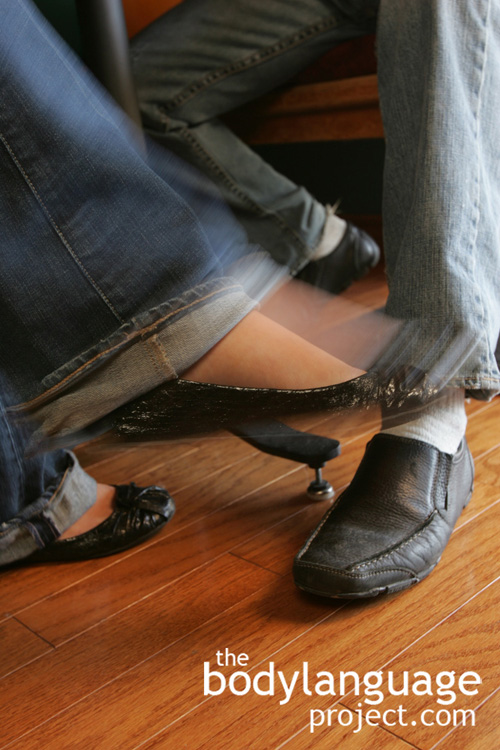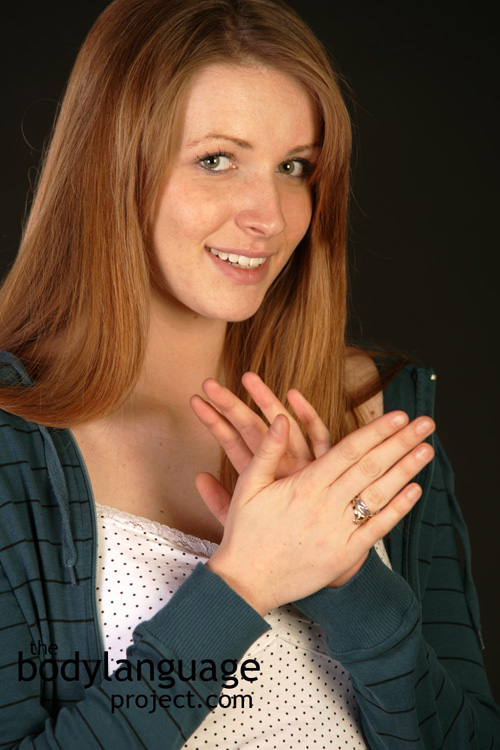Body Language of Forced Laughter
Synonym(s): Stress Laugh.
Description: Laughter that is not due to real enjoyment.
In One Sentence: Forced laughter indicates the desire to appease another person.
How To Use it: Stress laughing shows that you are willing to submit to the authority of another person or laugh to be part of a group or simply to be polite. Laughing at bad jokes is useful to lower ranking employees whom should, by all means, laugh at the jokes of their bosses, no matter how funny they are found to be. This sends the message that you are willing to be a “team player” and placate.
Context: General, Stress.
Verbal Translation: “I’m not really happy nor do I find that funny, but I’m laughing to show my appeasement and submission to you and to join in on your amusement.”
Variant: See Laughter.
Cue In Action: a) The boss made a joke that no one found funny, but everyone still laughed. b) She was presenting her findings to the University. She giggled often showing her nervousness and lack of confidence, making everyone take her a little less seriously, but still welcoming her speech and empathizing with her discomfort.
Meaning and/or Motivation: Laughter that is meant to disguise hidden anxiety or disagreement, stress, be polite, or in effort to connect with new people. We use a stress-laugh to dispel and ease tension both for our own purpose and that of others. Laughter is a fear based response and also shows others that we are submitting to them.
Cue Cluster: Other agreement indicators such as head nods, eye contact and will accompany a forced laughter. It can also be accompanied by blushing, uneasy or quivering voice, and pacifying cue such as face and neck touching.
Body Language Category: Appease, Embarrassment (nonverbal), Energy Displacement, Excited body language, Fearful body language, Nervous body language, Shy nonverbal, Stressful body language, Submissive body language.
Resources:
Foley, Erin ; Matheis, Robert ; Schaefer, Charles. Effect of forced laughter on mood.(Abstract). Psychological Reports. 2002 90(1): 184(1).
Grammer, K., & Eibl-Eibesfeldt, I. 1990. The ritualisation of laughter. In W. Koch (Ed.), Naturalichkeit der Sprache un der Kultur: Acta colloquii 192–214
Hall, Jeffrey A. and Chong Xing. The Verbal and Nonverbal Correlates of the Five Flirting Styles. Journal of Nonverbal Behavior. 2015. 39:41–68. DOI 10.1007/s10919-014-0199-8
http://bodylanguageproject.com/articles/first-12-minutes-flirting-using-nonverbal-communication-study-reveals-26-body-language-cues-attraction/
Kawakami, Kiyobumi; Takai-Kawakami, Kiyoko; Tomonaga, Masaki; Suzuki, Juri; Kusaka, Tomiyo; Okai, Takashi. 2006. Origins of smile and laughter: a preliminary study. Early Human Development. 82 (1): 61.
Keltner, Dacher; Bonanno, George A. 1997. A study of laughter and dissociation: Distinct correlates of laughter and smiling during bereavement. Journal of Personality and Social Psychology. 73(4): 687-702.
MacDonald, C., 2004. A Chuckle a Day Keeps the Doctor Away: Therapeutic Humor & Laughter. Journal of Psychosocial Nursing and Mental Health Services 42(3):18-25.
Martin, Rod A. 2001. Humor, laughter, and physical health: Methodological issues and research findings Psychological Bulletin. 127(4): 504-519.
Moore, Monica. Courtship Signaling and Adolescents: Girls Just Wanna Have Fun. Journal of Sex Research. 1995. 32(4): 319-328.
http://bodylanguageproject.com/articles/girls-just-want-to-have-fun-the-origins-of-courtship-cues-in-girls-and-women/
Neuhoff, Charles C ; Schaefer, Charles. Effects of laughing, smiling, and howling on mood. Psychological reports. 2002 91(3 Pt 2): 1079-80.
Owren, Michael J.; Bachorowski, Jo-Anne 2003. Reconsidering the evolution of nonlinguistic communication: the case of laughter Journal of Nonverbal Behavior. 27(3): 183-200.
Panksepp, J., Burgdorf, J., “Laughing” rats and the evolutionary antecedents of human joy? Physiology & Behavior (2003) 79: 533-547.
Provine, Robert R.. 2000. The laughing species. Natural History. 109(10): 72-76.
Provine, Robert R. 2000. Laugh and the world laughs with you. Scientific American. 283(6): 108-110.
Provine, R. R. 1992. Contagious laughter: Laughter is a sufficient stimulus for laughs and smiles. Bulletin of the Psychonomic Society 30: 1- 4.
Provine, R. R. 1993. Laughter punctuates speech: Linguistic, social and gender contexts of laughter. Ethology 95: 291-298.
Provine, R. R., and K. R. Fischer. 1989. Laughing, smiling, and talking: Relation to sleeping and social context in humans. Ethology 83: 295-305.
Provine, R. R., and Y. L. Yong. 1991. Laughter: A stereotyped human vocalization. Ethology 89: 115-124.
Provine, R.R. Contagious yawning and laughing: Everyday imitation and mirror-like behavior. Behavioral and Brain Science. 28: 142.
Priest, RF; Thein, MT. 2003. Humor appreciation in marriage: Spousal similarity, assortative mating, and disaffection. Humor-international journal of humor research, 16(1): 63-78.
Sturman, Edward D. Invluntary Subordination and Its Relation to Personality, Mood,
and Submissive Behavior. Psychological Assessment. 2011. 23(1): 262-276 DOI: 10.1037/a0021499
http://bodylanguageproject.com/articles/nonverbal-submission-men-women-depression-critical-examination-use-disuse-submission/





